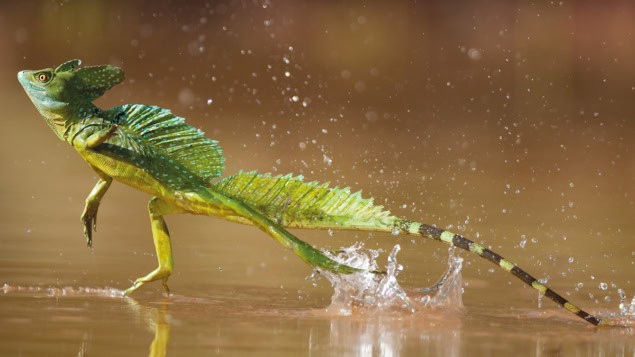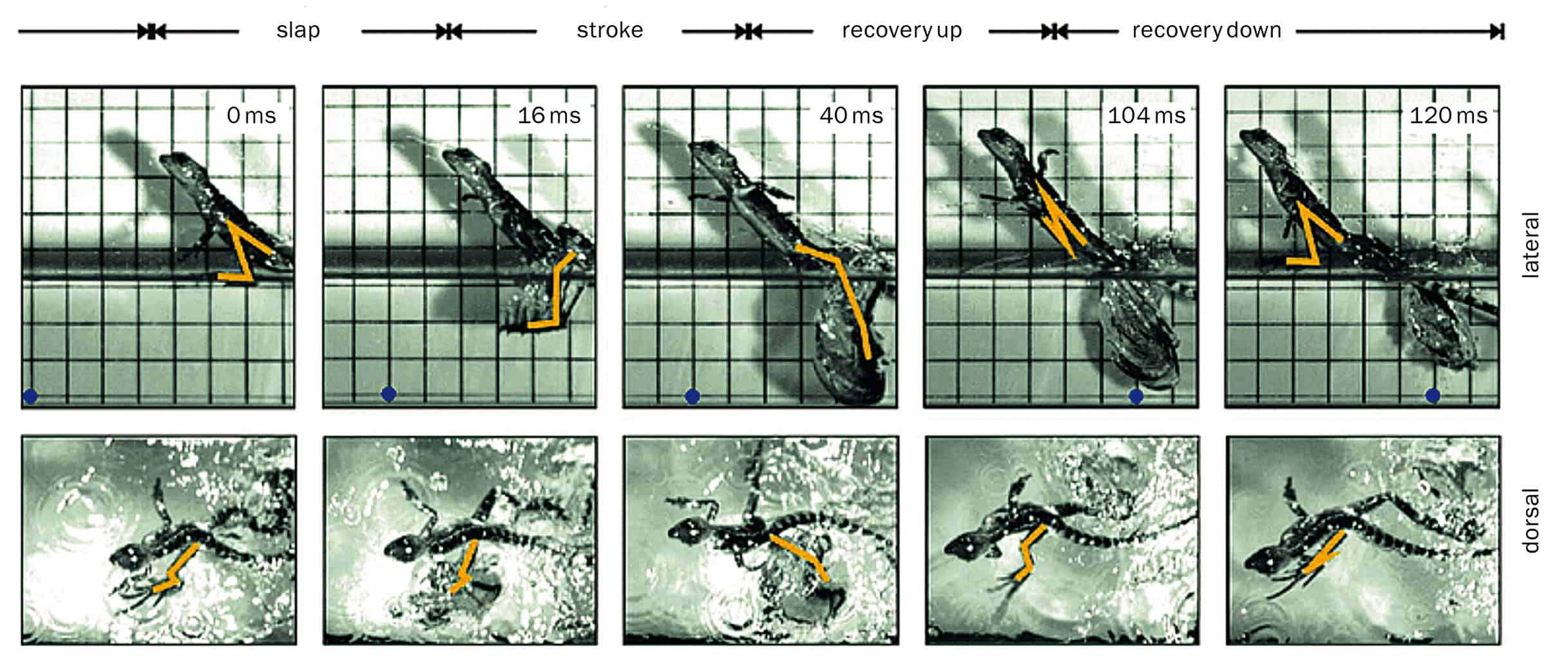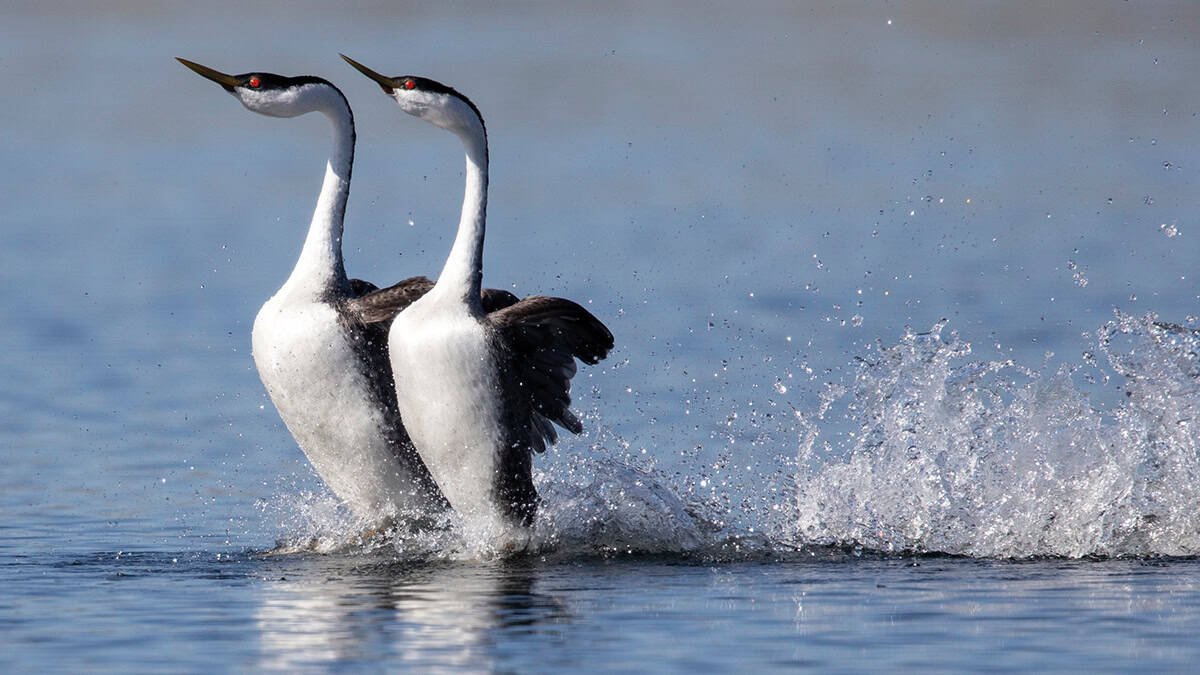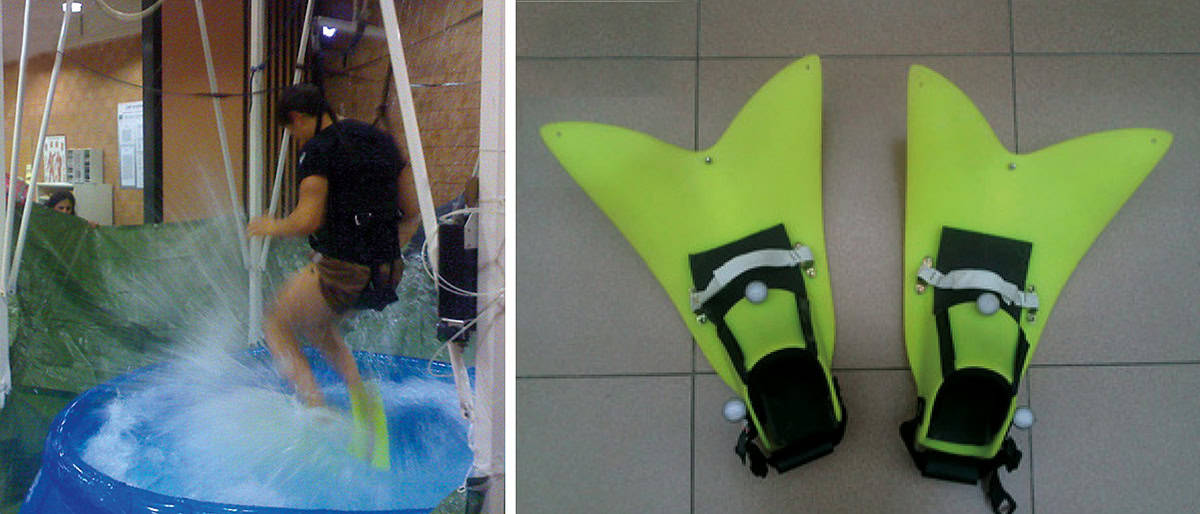Far too heavy to be supported by surface tension, basilisk lizards and western grebes can sprint for short distances on water. To mark the 2024 Paris Olympics, Nicole Sharp examines the physics behind water-running and asks whether human athletes could ever accomplish the same feat

The world’s best runners are gathering in Paris for the 2024 Summer Olympics. Sprinters vying for the title “world’s fastest” hope to chase records set by all-time greats such as Usain Bolt and Florence Griffith-Joyner, competing on a highly engineered athletic track. Across the Atlantic, however, a different type of sprinter is practising its craft daily, not on polymer-laced rubber, but on water.
Basilisk lizards – nicknamed “Jesus Christ lizards” for their ability to run on water – don’t run for accolades or titles; they’re just looking to escape predators. When threatened, these pint-sized powerhouses take a running start on land, then skitter across the water. At 100 grams, basilisk lizards are hardly heavyweights, but they’re much too heavy to be supported by surface tension.
The ability to run on water is one of the most impressive feats in the animal kingdom – a triumph of physics as much as biology. It’s a question that has intrigued researchers for many years, but there’s something else all good physicists will want to know: could humans moving at speed ever run on water?
Slap, stroke, recover
Biologist Tonia Hsieh was first struck by the basilisks’ water-running in her undergraduate class on herpetology – the study of amphibians and reptiles. She couldn’t stop thinking about their ability to seemingly defy the laws of physics, so she pursued a PhD at Harvard University in 1999 chasing these little reptiles’ superpower.
A few years before, two other Harvard researchers had studied the same problem, developing a mathematical model that was Hsieh’s starting point (Nature 380 340). Tom McMahon and Jim Glasheen had analysed videos of the lizards and showed that each step they take across the water can be broken down into three stages – slap, stroke and recovery (see “On your marks” image).

When the basilisk runs, its foot slaps the water’s surface, just like a human sprinter on a track. With every footfall, the runner drives their shoe into the track, and the track pushes back. That’s Newton’s third law: every action has an equal and opposite reaction. The same holds for the basilisk. Each time the lizard’s foot hits the water, the liquid exerts an upward force. The larger the lizard’s foot and the faster it hits the water, the more upward force the slap generates.
Unlike a human sprinter, the basilisk is running on a yielding surface. When its foot dips into the water, the basilisk extends its leg like a swimmer’s arm, but it moves so fast that in the milliseconds before the water rushes in, an air-filled cavity forms above the foot. This is the stroke. During this phase the lizard’s foot experiences a lifting force proportional to the amount of water it moves.
In the final phase – recovery – the basilisk quickly pulls its foot up and lifts it for the next slap. Anyone who’s waded through knee-high water knows this isn’t easy. The basilisk’s foot must make it out before the water closes around it, otherwise it will be dragged down.
Glasheen and McMahon showed that thanks to the basilisk’s speed and large feet, the slap–stroke–recover sequence should generate enough upward thrust to support the lizard’s weight. For Hsieh, however, many questions remained. Staying above the water is only the first challenge: the basilisk also needs to move forward, and it needs to do this while balancing on the ever-changing surface of a liquid.
Like running on a mattress
To tackle these questions, Hsieh built a watery track for her runners using large aquarium tanks. A platform on either end gave her subjects solid starting and finishing lines. Hsieh stood by with a high-speed camera, poised to capture each run. She soon discovered, however, the challenges of running a scientific experiment on live, free-willed lizards.
“I had so many videos of them running across the water and then turning and running smack into the window,” she recalls. For useful data, she therefore had to wait until the lizards decided to run. Eventually, though, Hsieh was able to capture the basilisk foot’s speed and orientation in each phase. To calculate the forces, however, she needed to capture the motion of the water as well as the lizards.
Fluid dynamicists use a technique called particle image velocimetry (PIV) to measure the speed and direction (i.e. the velocity) of flow. For an analogy, think about late-afternoon sunlight slanting through a window. If it falls at a particular angle, the light will illuminate the dust particles in the room, revealing air currents that are otherwise invisible. PIV works the same way.
Hsieh filled her tank with 12-micron glass spheres that matched the water’s density. These tiny particles acted as tracers – just like dust – that followed the same path as the water. To illuminate them, she replaced sunlight with a 1 mm-thick laser sheet focused near the basilisk’s foot. By tracking the particles, Hsieh saw exactly how the lizards accomplished their gravity-defying sprint (PNAS 101 16784).
The lizards were using the water like a squishy starting block – propelling themselves forwards as well as upwards. During the slap, they did this by angling their feet slightly down, so they met the surface at an angle, and during the stroke they were pushing against the wall of the cavity.
But Hsieh’s biggest surprise was the strong side-to-side forces, ranging from 37–79% of the lizard’s body weight. The basilisks were throwing themselves from side-to-side like a wobbling toddler. “It never occurred to me,” says Hsieh, “that if you can produce enough force to stay on top of water, how are you going to maintain your balance? That’s a really major problem.”
Everything we take for granted about moving around in the world is actually really, really hard
Imagine sprinting on a thick foam mattress. With every step, you’ll wobble as you try to stay balanced. That, Hsieh realized, explained the basilisk’s ungainly sideways motion. “They’re basically tripping every single step, and they’re catching themselves. Everything we take for granted about moving around in the world is actually really, really hard.”
Water running is a young basilisk’s game. As Hsieh’s lizards grew, they became bigger and slower, struggling to support their weight – potentially bad news for aspiring human water runners. However, these lightweight critters don’t have the last word in running on water. In fact, nature’s most successful water runners outweigh the basilisk lizard by a factor of 10.
Water dancers
Western grebes and their near-doppelgängers, Clark’s grebes, are unassuming birds. They have slender, swan-like necks and black and white plumage. Their most striking feature is their red eyes. But behind this unremarkable exterior lurks a water-running powerhouse.
Biologist Glenna Clifton first saw the grebes in the early 2010s in a BBC documentary. At the time she was a PhD student at Harvard, and her animal-behaviour class was discussing mating displays. Like many birds, the western and Clark’s grebes begin their displays with mated pairs mirroring one another. A head shake, a riffle of a beak through plumage. Then the birds extend their long necks, lock eyes and rush (see “It takes two” image).

As a synchronized pair, the grebes rise out of the water, feet beating furiously, wings held stationary behind them. With heads proudly raised, the birds run up to 20 metres in just a few seconds. Having studied ballet since the age of three, Clifton was “really sparked and captivated” by this dance. But apart from previous work on basilisk lizards, she found no information on the water-running physics of grebes, so she set out to answer the question herself.
Grebes won’t run on water in a laboratory, so Clifton planned a field study to capture wild grebes rushing. In May 2012 she set out for Oregon’s Upper Klamath Lake with two high-speed cameras and two field assistants. They called themselves the Grebe Squad.

Could humans run on water?
Each morning the group pitched up tents and arranged their equipment on a narrow spit of land between the highway barrier and the lake. Their experiment used two synchronized cameras, placed about 40 metres apart, to view the same birds from different angles. By placing a known object – in their case, a T-shaped calibration wand – in the field of view of both cameras, they could work out the sizes, angles and positions of the grebes (J. Exp. Biol. 218 1235).
This sounds straightforward, but it was anything but. The Grebe Squad spent days on the lake, scanning hundreds of birds for signs of an imminent rushing display. “We usually got about three to seven seconds of warning,” Clifton says, “because they would have a certain look in their eye. They would call to each other…with a certain kind of intensity.” With that scant warning, they coordinated over walkie-talkies, pointed both cameras, manually focused and collected 1.7 seconds of high-speed footage. Then they raced to get the calibration wand to the same spot the birds had been in before either camera moved. An errant elbow, a gust of wind or a sinking tripod would ruin the data.
“Grebes are, arguably, way stronger water-runners than basilisk lizards because they start from within the water,” Clifton explains. “Imagine treading water fast enough to get up out of it. It’s just crazy.” Synchronized swimmers and water-polo players would agree. Typically, a swimmer (or bird) is supported by buoyancy. A floating object displaces a water volume equal to the object’s weight, as described by Archimedes’ principle. In turn, the object feels an upward, buoyant force equal to the displaced water’s weight. As the grebe rises, it displaces less and less water, giving it less and less buoyant force.
Is there a balance between foot size and energy expended that would let humans run on water?
Without buoyancy holding it up, the grebe counters its weight the same way a basilisk does – by slapping its feet. And the Grebe Squad’s data revealed that grebes slap a lot. During rushing, Clifton says, “[grebes] take up to 20 steps per second, which is a really high stride rate for animals.” An Olympic sprinter, in contrast, takes about five steps per second.
To estimate the forces a grebe produces, Clifton dropped aluminium models of grebe feet into a laboratory water tank and measured the impact force. The grebes’ feet are proportionally bigger and they move faster than the basilisk’s. They produce stronger slaps capable of supporting 30–55% of the grebe’s mass, compared to only 18% for the lizard’s. If a basilisk lizard were scaled up to the mass of a grebe, its feet would still be 25% smaller in area than the grebe.
Larger feet push more water with each slap, but they also require more energy to accelerate and they generate more drag. Is there a balance between foot size and energy expended that would let humans run on water?
Could humans run on water?
Although it was built for basilisk lizards, the model developed by Glasheen and McMahon at Harvard also tells us what it takes for a human to run on water. The idea is simple: to run on water, the total impulse from a slap and stroke must be greater than the impulse needed to support the runner’s mass. Impulse is simply a force multiplied by the time over which a force is applied – in this case, the time between steps. With a little algebra and some simple assumptions, you can determine the slap velocity needed, given the runner’s mass and foot area, as well as the time between steps and the depth the foot reaches.

In their original paper, Glasheen and McMahon calculate that an 80 kg human with an average foot size and a world-class sprinter’s stride rate would have to slap the water at a speed of nearly 30 metres per second to support themselves. Unfortunately, the power needed for a stroke at that speed is almost 15 times greater than a human’s maximum sustained output. In other words, no human can run on water – at least, not on Earth.
That’s the theory, but does it stack up in reality? To find out, in 2012 a group led by Alberto Minetti, a physiologist at the University of Milan, studied whether reduced gravity conditions would enable humans to run on water (PLOS One 7 e37300). Their volunteers wore a special harness that reduced their effective weight to a fraction of its Earth-normal amount, along with fins that made their feet as proportionately large as a basilisk’s (see “All in a day’s work” images). Then they attempted to run on the spot in a small, inflatable pool. The video footage is spectacular.
The test subjects look more like cyclists than runners. Their thighs pump up and down, churning the water into splashes higher than their heads. Their legs stroke to a depth a little over halfway to their knees, but it’s clear that they manage to support their reduced weight for the seven to eight seconds the researchers deemed a success.
The team found that everyone could water-run at 10% of Earth’s gravity, but as they adjusted the harness so that the effective gravitational force increased, fewer runners could keep up. At 16% of Earth’s gravity – roughly equivalent to the Moon’s gravity – most of the runners could support themselves. At 22% of Earth’s gravity – still less than that on Mars – only one subject could. The Martian edition of the Space Olympics is unlikely to include water-running.

But water isn’t the only liquid found in our solar system. Titan, Saturn’s largest moon, has lakes and seas comparable to ours, and its gravitational acceleration is only 13.8% of Earth’s. (That’s a little less than our Moon’s.) Unlike Earth’s lakes, Titan’s are made of frigid liquid ethane and methane (see “Running on Titan” image).
So, could a human being – like current women’s 100 m world champion Sha’Carri Richardson – run on Titan’s lakes? Ethane – even at Titan’s 94 kelvin – is less dense than water, so it offers less impulse to runners. But Titan’s lighter gravity counters that.
At 45 kg, Richardson, who is representing the US in Paris, is petite but blisteringly fast. In the 2023 World Athletics Championships she won gold with a championship record of 10.65 seconds in the 100 m. Her UK size five shoes provide a good foot area. When sprinting (on land, admittedly), she takes ~4.6 steps a second. I’ll assume on ethane that she sinks about 8 centimetres – a bit less than the Italian water-runners – during each step.
To stay atop Titan’s ethane, Richardson would have to slap the surface at about 9.0 m/s. That slap would provide more than 60% of her necessary vertical impulse and require running at about 8.7 metres per second (31.2 kilometres per hour). Her world-championship time was significantly faster at 9.3 metres per second.
So quick dashes across Titan’s lakes are theoretically possible – at least for humanity’s fastest. Just make sure to dress warmly and maybe hold your breath.
- For more from Nicole Sharp about the fluid dynamics of animals, listen to the July edition of the Physics World Stories podcast.



